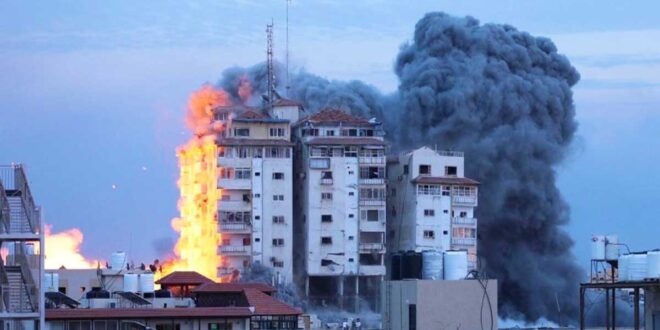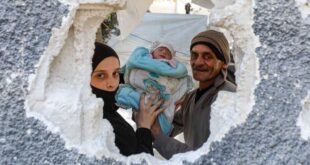Gen. Shashi Asthama
The asymmetric, irregular, dirty war triggered by the brutal terror attack by Hamas on Israel on October 07, 2023, targeting innocent civilians and children calls for global condemnation. A violent response by Israel using all its military might is on, which was an expected reaction, with death toll rising on hourly/daily basis predominantly of innocent civilians and children. While the provocation was grave for Israel, but the voices to distinguish between Hamas and innocent Palestinians and consequences of disproportionate response, along with hostage crisis has to be a subject of concern for Emergency Unity Government of Israel. The rhetoric to obliterate Hamas, is actually translating into unprecedented collateral damages on ground and obliteration of habitation in Gaza Strip with impractical ultimatum to million plus Palestinians to vacate Northern Gaza in 24 hours. The crisis is snowballing into one of the worst human disasters with potential to expand into regional conflict.
Contributing Factors to Current Crisis
While Israel and Palestinians both have legitimate right to live, have a homeland, govern and defend themselves, but lack of accommodation of these rights within the boundaries of Israel, West Bank and Gaza Strip has been problematic leading to bloodshed for over decades. While every peace propagator talks of two state solution but no such solution succeeded due to the competing claims to Jerusalem, which is crucial to Christians, Jews and Palestinians. The problem, therefore, remains how to divide that landmass into two states, as both sides want Jerusalem, because Palestinians can’t compromise on al-Aqsa Mosque (Third holiest shrine for Islam) and Jews can’t compromise on Temple Mount or Western Wall (the holiest site in Judaism). With complexities of entanglement of 167 Palestinian enclaves embedded in 203 Israeli settlements in the West Bank, it’s not really practical for anyone of them to leave its enclaves, which complicates the situation further.
In recent past a chain of events like Abraham Accord, formulation of I2U2 and potential deal between Israel and Saudi Arabia, indicated increasing acceptance of Israel in Arab World, which Palestinians in general, and Hamas and its backers in particular, saw as a threat, shrinking of their influence, dilution of Palestinian cause and loss of relevance for Hamas, as potent organization.
Over decades Israel has emerged as the most powerful military power in Middle-East controlling most of the claimed area including Palestinian settlements in West Bank directly, and Gaza Strip indirectly through six crossings with full control over coastline and airspace. With recent re-election of hardliner Netanyahu, the fear of further encroachment into their settlements and tighter control was growing, more so in the aftermath of fierce confrontations in the area of al-Aqsa Mosque in 2021, wherein Israeli muscle power demonstrated its might. The fact that today Israel has a state of its own which it fully controls, is not true for Palestinians, which will continue to be perceived as injustice by them. This unresolved issue is a recipe for future conflicts as well, even if the current crisis sees some awkward settlement.
Netanyahu’s attempt for judicial overhaul was viewed as power grab and the internal opposition to it as divided Israeli’s establishment. The redeployment of Israeli forces to control internal dissent with additional focus on West Bank in last two years, was seen as an opportunity by Hamas, coupled with sense of complacency in Southern Israel opposing Gaza Strip. The formidable, technologically enabled fencing was assumed to be impregnable; hence found to be inadequately manned violating important military principle that any obstacle, if not covered by troops and fire can be breached.
Strategy of Hamas
Hamas is designated as a terrorist group US, Canada, EU, Japan and Israel, but controls Gaza (post Israeli disengagement in 2005) and has a military wing. In 2006, Hamas won the last-held Palestinian legislative election, and started administering Gaza. In absence of further elections, Hamas claims to represent Palestinian cause, but its barbaric actions on 07 October have brought greater miseries to people of Gaza. It doesn’t recognize Israel as legitimate state, Oslo Accord 1993 and Palestinian Authority (PA) over it.
Decoding from Hamas point of view, it knew that Israeli forces have asymmetric advantage in combat power and military capabilities; hence a surprise terror attack was chosen to strike a blow on Israel to disrupt Arab- Israel engagement. The choice of Saturday (Jewish holiday) to launch offensive ‘Operation al-Aqsa Flood’ was to achieve surprise and its attack from land, air and sea indicates exhaustive planning and preparations for offensive to take on Israeli forces with speed and surprise. The scale and magnitude indicate that it was beyond the capacity of Hamas alone; hence possibility of external help can’t be ruled out.
The aim of Hamas was to weaponise utmost brutality, so that Israel is provoked beyond limits to respond disproportionately, causing heavy casualties to innocent Palestinians in Gaza, which would invite favorable reaction in their support from Arab countries and most radical Islamic countries and organisations. Hamas expects to put the Palestinian issue from back burner to forefront once again and invite global criticism for Israel for disproportionate response and HR violations.
The operational objective of Hamas was to get maximum hostages from Israel, who can be used as bargaining chip or human shield to negotiate with a much powerful adversary. While Hamas has no concern for human lives, Israel in previous occasions have conceded releasing many Palestinian in exchange of few Israeli hostages; however, it may not remain so liberal now and may take calculated risks with hostages in attempt to obliterate Hamas. With extensive tunnel network below civil habitation, Hamas will conserve its fighters, continue sporadic rocket attacks, conserve ammunition for prolonged fight to draw Israeli forces into fighting in built up areas, using ground knowledge of thick built-up area to its advantage to overcome the asymmetry in military arsenal.
Strategy of Israel
Having suffered heavy casualties due to serious intelligence failure or underplaying battle indicators and underestimating Hamas due to superiority complex of its military power, Israel first priority was to evict Hamas militants from its territory, which it claims to have achieved. It is continuing standoff attacks in Gaza strip to soften up Hamas positions and shaping the battlefield for ground offensive.
Israel understands the gravity of hostage crisis; hence it is trying backdoor negotiations for their release through various mediators like Qatar, Turkey, Egypt and even USA. It has launched exhaustive information and psychological war for early consolidation of Hamas and to mitigate criticism for its disproportionate response, but it knows the magnitude of collateral damage of its offensive named ‘Operation Swords of Iron’.
While Israeli rhetoric of obliterating Hamas is a political domestic compulsion for Netanyahu, but the fact that Hamas has its leaders and cadres outside its striking distance also and it involves heavy fighting in built up area in most densely populated area, this rhetoric may be ambitious. If USA couldn’t obliterate al-Qaeda in two decades, obliterating Hamas may not be as easy, as it is being announced. The idea of shifting civil population from North Gaza to South to clear the strip in segments is marred with a possibility of Hamas also merging and shifting itself along with hostages with civil population.
Possibility of Expansion
With increasing civilian casualties in Gaza, the global human right concern will increase and the anger of some neighbours and Islamic radical organizations will provoke some to join in, although USA, the strongest ally of Israel is trying its best to prevent it. It has postured its strongest aircraft carrier groups (USS Gerald R Ford carrier group being joined by USS Dwight D Eisenhower Carrier Strike Group) in Mediterranean Sea as a deterrent and its secretary of state is visiting every possible stake holder to prevent expansion. Hezbollah despite US warnings may increase its scale of engagement, which is much more potent force than Hamas. Although evidences of direct involvement of Iran in Hamas attack of 07 October haven’t emerged, the alleged ongoing financial, moral, and material support to Hamas and Hezbollah can’t be ruled out. The fact that Iran seems to be the beneficiary of break up in Israel Saudi Arabia normalization, and is warning Israel to stop strikes in Gaza, puts the needle of suspicion on it. Some actions from Syrian front also, with Iranian help, can’t be ruled out. Presently US is also playing down Iran angle, as it is in no mood to open another front to keep the crisis localized.
Way Ahead
With more than 2450 Palestinians killed and thousands wounded in eight days by Israeli strikes in Gaza, their casualty figures including of innocent women and children have increased to almost double of total casualties of Israelis in brutal terror attack on 07 October attack and beyond (1300 killed and 3400 wounded). It is giving rise to voices of criticism for going beyond self-defence, disproportionate response and collective punishment. Considering the excessive initial pain by Hamas to Israel, the West has been tight lipped about Israel’s blockage of humanitarian requirements like food, water, shelter and electricity so far, but criticism can’t be avoided for too long. The United Nations (UNRWA) call for humanitarian corridor not conceded by Israel, insisting on impractical total evacuation may soon drift global opinion away from narrative of Netanyahu.
Israel is determined for ground offensive, with rhetoric of obliteration Hamas and seems ready to accept criticism for collateral damages. While its military might may prevail to destroy Gaza with harsh punishment to all its occupants, the complete destruction of Hamas ideology is next to impossible, if US and collective West couldn’t obliterate al-Qaeda, ISIS completely even after years of war. Israeli strategy ignores the fact that in Counter insurgency/terrorist operations (COIN) people are centre of gravity and excessive civilian casualties can give adequate reason for developing next generation of Hamas terrorists, even if the current one is defeated. For Palestinians, the poor leadership of Abbas, whose term expired 12 years ago lacking popular mandate and radicalised Hamas the promise of peace and its legitimate rights looks bleak, notwithstanding genuineness of their cause.
 Geostrategic Media Political Commentary, Analysis, Security, Defense
Geostrategic Media Political Commentary, Analysis, Security, Defense





